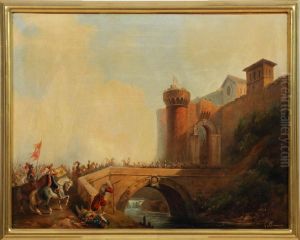Gaetano Bianchi Paintings
Gaetano Bianchi was an Italian artist born in 1880 in the vibrant city of Florence, Italy, during a period marked by significant developments in the arts and culture. Florence, being the cradle of the Renaissance, profoundly influenced Bianchi's artistic direction. His early life was steeped in an environment that celebrated artistic heritage, fostering a deep appreciation for the arts from a young age. Bianchi's education and formative years as an artist were characterized by traditional training, emphasizing mastery of technique, and a deep study of the Renaissance masters, which would later be reflected in his own works.
Bianchi's career spanned a period of great change in the art world, transitioning from the 19th to the 20th century. He was known for his remarkable versatility, dabbling in various mediums including painting, sculpture, and decorative arts. His style, although rooted in classical traditions, also embraced elements of Art Nouveau and Symbolism, popular movements of his time. Bianchi's works were characterized by their exquisite detail, vibrant color palette, and often, a certain ethereal quality that reflected his interest in mythological and allegorical subjects.
Throughout his career, Gaetano Bianchi became well-regarded in Italian art circles, contributing significantly to the cultural life of Florence and beyond. He participated in numerous exhibitions, both nationally and internationally, gaining recognition for his artistic prowess. Despite his contributions, Bianchi remained somewhat of an unsung hero in the broader context of art history, overshadowed by contemporaries who ventured into more avant-garde territories.
Bianchi's death in 1938 marked the end of an era that bridged the classical and modern worlds of art. His legacy, though not as widely celebrated as some of his peers, left an indelible mark on the Italian art scene. Bianchi's body of work continues to be studied and appreciated by art historians and enthusiasts for its technical excellence and evocative beauty. His life and art remain a testament to the enduring influence of the Renaissance on Italian artists, even into the modern age.
